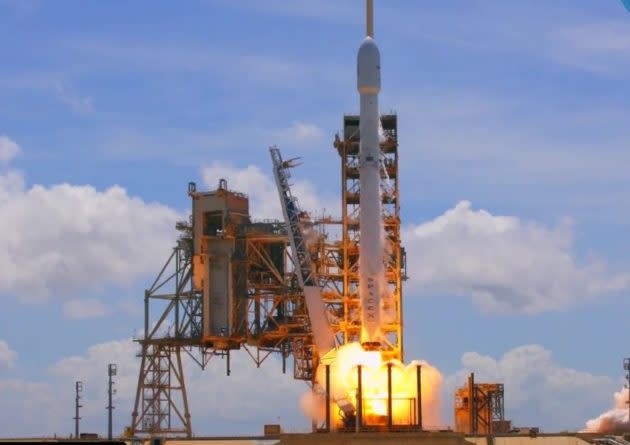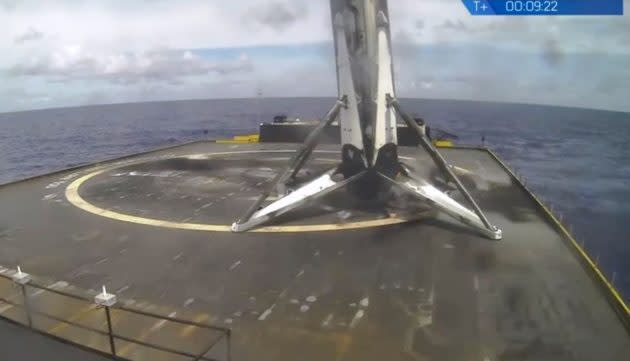SpaceX leads off its rocket doubleheader with Falcon 9 re-launch and re-landing

For the second time ever, SpaceX has sent a telecommunications satellite into orbit on a previously flown Falcon 9 rocket – but today’s launch of BulgariaSat-1 is notable for other reasons as well.
The first-stage booster landed successful at sea after liftoff, marking the first time the same rocket has made successful touchdowns off America’s East Coast as well as the West Coast.
And if the schedule holds, yet another SpaceX launch will take place two days from now, to put 10 more satellites into orbit for the Iridium NEXT telecom constellation.
The two launch pads are a continent away from each other: BulgariaSat-1 went up from Launch Complex 39A at NASA’s Kennedy Space Center in Florida, while Sunday’s Iridium NEXT liftoff is set for Vandenberg Air Force Base in California.
Nevertheless, the summer weekend doubleheader is a one-two punch for SpaceX’s launch teams, for its mission control operation in Hawthorne, Calif., and for the company’s legions of fans.
The closely timed schedule wasn’t originally planned that way: The launch of the first Bulgarian satellite designed for geostationary orbit had been scheduled for June 19, while Iridium’s mission was set for liftoff on June 29.
But the Iridium launch was moved up to take advantage of an opening in Vandenberg’s range availability, while the BulgariaSat-1 mission was postponed to give SpaceX extra time to replace a suspect fairing valve on the Falcon 9.
Today’s countdown was delayed by an hour to run additional ground checks, but the two-stage Falcon 9 rocket made a trouble-free liftoff at 3:10 p.m. ET (12:10 p.m. PT), in the middle of a two-hour launch window.
The first-stage booster was used previously to launch the first 10 Iridium NEXT satellites from Vandenberg back in January. After landing on a ship in the Pacific, the booster was recovered, refurbished and reused, as part of SpaceX’s long-running campaign to reduce the cost of access to space through rocket reusability.
SpaceX’s first reused booster helped put the SES-10 telecom satellite into geostationary transfer orbit in March. Eventually, the company aims to get recovered boosters ready for reflight within 24 hours.
After launch and stage separation, today’s Falcon 9 booster relit its engines and guided itself down for a landing on an autonomous drone ship stationed in the Atlantic Ocean. The ship is christened “Of Course I Still Love You,” in a tribute to the sentient starships of Iain M. Banks’ science-fiction novels.
Before launch, SpaceX’s billionaire founder, Elon Musk, said the prospects for recovery were dim due to the stresses of atmospheric re-entry. “Good chance rocket booster doesn’t make it back,” he tweeted.
But when all was said and done, the booster stood tall on the drone ship as more than 65,000 users watched via the YouTube video stream.

Musk said the rocket had a rough ride but hinted that it could be fixed up:
Rocket is extra toasty and hit the deck hard (used almost all of the emergency crush core), but otherwise good
— Elon Musk (@elonmusk) June 23, 2017
It’s an aluminum honeycomb cartridge, so only a couple of hours to replace
— Elon Musk (@elonmusk) June 23, 2017
BulgariaSat-1, which was built for the eastern European country by California-based SSL, is designed to provide direct-to-home television and data communications services over an area centered in the Balkans and stretching from western Europe to the Middle East, North Africa and the Caucasus. It’s expected to be in operation for at least 15 years.
Sunday’s Iridium launch is set for 1:25 p.m. PT. It’s due to deliver a second set of 10 satellites into low Earth orbit for Iridium’s next-generation communications constellation.
SpaceX is hoping for a replay of January’s successful Iridium NEXT launch, including another successful booster landing on the company’s Pacific Ocean drone ship, “Just Read the Instructions.” (That name is another nod to Banks’ starships.)
Eight SpaceX launches in all are due to fill out the 70-satellite configuration in low Earth orbit, plus on-orbit spares. The Iridium NEXT network is scheduled to be completed in 2018.
More from GeekWire:
SpaceX closes out a rocket doubleheader with Iridium launch and booster landing
SpaceX returns to flight with Iridium satellite launch – and rocket landing!
Third time’s the charm as SpaceX’s Falcon 9 rocket launches Intelsat 35e satellite
Get a drone’s-eye view of SpaceX’s Falcon 9 rocket landing – and much, much more